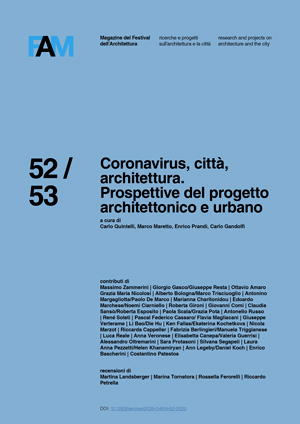Il cambiamento delle abitudini urbane in Svezia durante la pandemia di Coronavirus
Pubblicato 2020-12-11
Parole chiave
- Pandemia di Coronavirus,
- cambiamento delle abitudini,
- disuguaglianza nelle condizioni di vita,
- diversità dello spazio pubblico,
- sostenibilità
Come citare
Abstract
Durante la pandemia di Coronavirus sono stati messi in atto vasti interventi per limitare la diffusione del Covid-19. Le autorità, le imprese e le organizzazioni hanno introdotto restrizioni globali. Al fine di verificare l’eventuale acquisizione di nuove abitudini, abbiamo inviato un questionario web (PPGIS) comprensivo di mappe agli abitanti di tre città della Svezia; Stoccolma, Uppsala e Göteborg. Dai risultati acquisiti nel primo mese, si constatano drammatici cambiamenti delle abitudini. Molto frequentati risultano soprattutto i luoghi che offrono servizi, mentre vengono evitati i luoghi dove normalmente si lavora o si studia. I più frequentati sono i luoghi dove esiste la possibilità dell’isolamento, soprattutto l’accesso a spazi verdi facilmente raggiungibili. La pandemia rafforza le disuguaglianze urbane già esistenti e l'accesso alle risorse urbane e agli spazi verdi diventa ancora più importante in aree caratterizzate da povertà e sovraffollamento.
Riferimenti bibliografici
- AMIN A. (2012) – Land of Strangers. Polity, Cambridge.
- FAINSTEIN S. S. (2010) – The Just City. Cornell University Press, New York.
- HANSON J. (2000) - “Urban Transformations: A History of Design Ideas”. Urban Design International, 5, 97–122
- HANSSON E., Albin M., Rasmussen M. and Jakobsson K. (2020) – ”Stora skillnader i överdödlighet våren 2020 utifrån födelseland”. Läkartidningen, 2920: 117:20113.
- HARTIG T. and Kahn Jr P. H. (2016) – “Living in cities, naturally”. Science, 352(6288), 938–940.
- HILLIER B. (1996) – Space is the Machine: a configurational theory of architecture. Cambridge University Press, Cambridge.
- HILLIER B. (2010) – “What Do We Need to Add to a Social Network to Get a Society?”. The Journal of Space Syntax, 1(1), 41–58.
- KOCH D. (2016) – “On Avoidance: Reflections on Processes of Socio-spatial structuring”. Civil Engineering and Architecture, 4(2), 67-78.
- KOCH D., Legeby A. and Miranda Carranza P. (2019) “Suburbs and Power: Configuration, Direct and Symbolic Presence, Absence, and Power in The Swedish Suburb Gottsunda”. In: Proceedings of the 12th Space Syntax Symposium, Beijing Jiatong University, Beijing.
- LEGEBY A. (2013) – Patterns of Co-Presence: Spatial Configuration and Social Segregation. Stockholm, KTH.
- LEGEBY A. and MARCUS L. (2011) – “Does Urban Structure of Swedish Cities Inhibit the Sharing of Public Space?”. Built Environment, 37(2), 155–169.
- MARCUS L. and KOCH D. (2017) – “Cities as implements or facilities – The need for a spatial morphology in smart city systems”. Environment and Planning B, 44(2), 214-226.
- PREM K., LIU Y., RUSSELL T. W., KUCHARSKI A. J., EGGO R. M., DAVIES N., Centre for the Mathematical Modelling of Infectious Diseases COVID-19 Working Group, JIT M. and KLEPAC P. (2020) – “The effect of control strategies to reduce social mixing on outcomes of the COVID-19 epidemic in Wuhan, China, a modelling study. The Lancet, Public Health, 5(5), e261-270.
- VAUGHAN L. and ARBACI S. (2011) – “The Challenges of Understanding Urban Segregation”, Built Environment, 37(2), 128–38.
- VAUGHANL. (2015) – Suburban Urbanities: Suburbs and the Life of the High Street. UCL, London.
- SAMUELSSON K., GIUSTI M., PETERSON G. D., LEGEBY A., BRANDT S. A., and BARTHEL S. (2018) – ”Impact of environment on people’s everyday experiences in Stockholm”.Landscape and Urban Planning, 171, 7–17
- TONKISS F (2013) – Cities by design: the social life of urban form. Polity, Cambridge.
- YOUNG I. M. (1996) – “City Life and Difference”. In. S. S. Fainstein and S. Campbell (eds.), Readings in Urban Theory. Blackwell, Oxford.
- ZUKIN S. (1995) – The Culture of Cities. Blackwell, Oxford.


